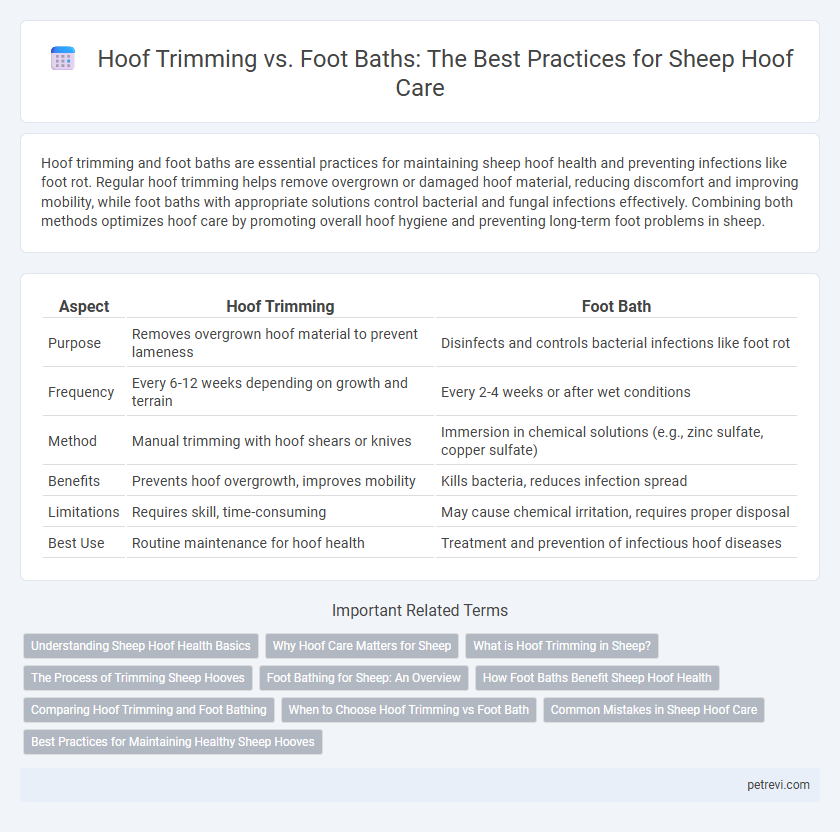Hoof trimming and foot baths are essential practices for maintaining sheep hoof health and preventing infections like foot rot. Regular hoof trimming helps remove overgrown or damaged hoof material, reducing discomfort and improving mobility, while foot baths with appropriate solutions control bacterial and fungal infections effectively. Combining both methods optimizes hoof care by promoting overall hoof hygiene and preventing long-term foot problems in sheep.
Table of Comparison
| Aspect | Hoof Trimming | Foot Bath |
|---|---|---|
| Purpose | Removes overgrown hoof material to prevent lameness | Disinfects and controls bacterial infections like foot rot |
| Frequency | Every 6-12 weeks depending on growth and terrain | Every 2-4 weeks or after wet conditions |
| Method | Manual trimming with hoof shears or knives | Immersion in chemical solutions (e.g., zinc sulfate, copper sulfate) |
| Benefits | Prevents hoof overgrowth, improves mobility | Kills bacteria, reduces infection spread |
| Limitations | Requires skill, time-consuming | May cause chemical irritation, requires proper disposal |
| Best Use | Routine maintenance for hoof health | Treatment and prevention of infectious hoof diseases |
Understanding Sheep Hoof Health Basics
Sheep hoof health is crucial for preventing infections like foot rot and maintaining mobility, with regular hoof trimming helping to remove excess growth and reduce debris buildup. Foot baths, typically containing zinc sulfate or copper sulfate solutions, effectively combat bacterial and fungal infections by disinfecting hooves and promoting healing. Combining routine trimming with targeted foot baths ensures optimal hoof condition and reduces the risk of lameness in sheep flocks.
Why Hoof Care Matters for Sheep
Proper hoof care in sheep is essential to prevent lameness, which can lead to reduced mobility and impaired grazing behavior, directly affecting overall health and wool production. Regular hoof trimming controls overgrowth and minimizes the risk of infections such as foot rot, while foot baths with antiseptic solutions help eliminate bacteria and promote healing. Maintaining healthy hooves supports sheep welfare, enhances productivity, and reduces veterinary costs associated with chronic hoof diseases.
What is Hoof Trimming in Sheep?
Hoof trimming in sheep involves the regular cutting and shaping of hooves to prevent overgrowth, reduce the risk of infections, and maintain proper gait. It is essential for controlling foot rot and other hoof-related diseases that can impair mobility and overall health. Proper hoof trimming helps improve animal welfare and productivity by ensuring sheep can move comfortably and access feed effectively.
The Process of Trimming Sheep Hooves
Trimming sheep hooves involves carefully cutting away overgrown hoof material to prevent lameness and promote healthy foot structure. This process requires regular inspection, identifying areas of excess growth, and using specialized hoof shears to shape and balance the hoof properly. Maintaining an optimal trimming schedule reduces the risk of foot rot and other hoof-related diseases, ensuring sheep mobility and overall well-being.
Foot Bathing for Sheep: An Overview
Foot bathing for sheep involves immersing hooves in a disinfectant solution to prevent and treat foot rot and other infections, promoting healthier hoof conditions. Commonly used solutions include zinc sulfate and copper sulfate, which effectively reduce bacterial pathogens responsible for lameness. Regular foot bathing complements trimming by minimizing disease spread and maintaining optimal hoof hygiene in flock management.
How Foot Baths Benefit Sheep Hoof Health
Foot baths effectively reduce bacterial infections such as foot rot by killing pathogens on the sheep's hooves, promoting healthier tissue and preventing lameness. Soaking hooves in disinfectant solutions softens the keratinized tissue, making subsequent hoof trimming less stressful and more precise. Regular foot bath treatments complement hoof trimming by maintaining optimal hoof hygiene and reducing the frequency of severe hoof problems.
Comparing Hoof Trimming and Foot Bathing
Hoof trimming in sheep involves mechanically removing overgrown or damaged hoof material to prevent lameness and promote healthy hoof growth. Foot bathing uses chemical solutions like zinc sulfate or copper sulfate to disinfect hooves, controlling bacterial infections such as foot rot and scald. Combining regular hoof trimming with periodic foot baths offers a comprehensive approach to maintaining optimal hoof health and reducing disease incidence in sheep flocks.
When to Choose Hoof Trimming vs Foot Bath
Hoof trimming is essential when sheep exhibit overgrown hooves, uneven wear, or structural issues that can impede mobility and increase infection risk. Foot baths are most effective for preventing and managing infectious diseases like footrot, especially in wet or muddy conditions where bacteria thrive. Choose hoof trimming for mechanical correction and foot baths for targeted infection control based on environmental risk and clinical signs.
Common Mistakes in Sheep Hoof Care
Frequent mistakes in sheep hoof care include neglecting regular trimming, which can lead to overgrown hooves and increased risk of lameness, and failing to use foot baths properly to prevent infections like footrot. Over-reliance on trimming without foot bathing can miss controlling bacterial buildup, while improper foot bath solutions or concentrations reduce effectiveness against pathogens. Consistent, balanced hoof management combining correct trimming techniques with appropriately timed foot baths is essential to maintain sheep mobility and prevent costly health issues.
Best Practices for Maintaining Healthy Sheep Hooves
Regular hoof trimming is essential for preventing overgrowth and minimizing the risk of infections such as footrot in sheep. Incorporating foot baths with appropriate antiseptic solutions, such as zinc sulfate or copper sulfate, effectively reduces bacterial buildup and promotes overall hoof health. Combining these best practices ensures optimal hoof condition, reduces lameness, and enhances sheep welfare.
Hoof Trimming vs Foot Bath for Sheep Hoof Care Infographic

 petrevi.com
petrevi.com